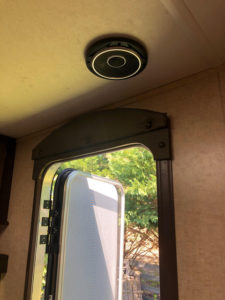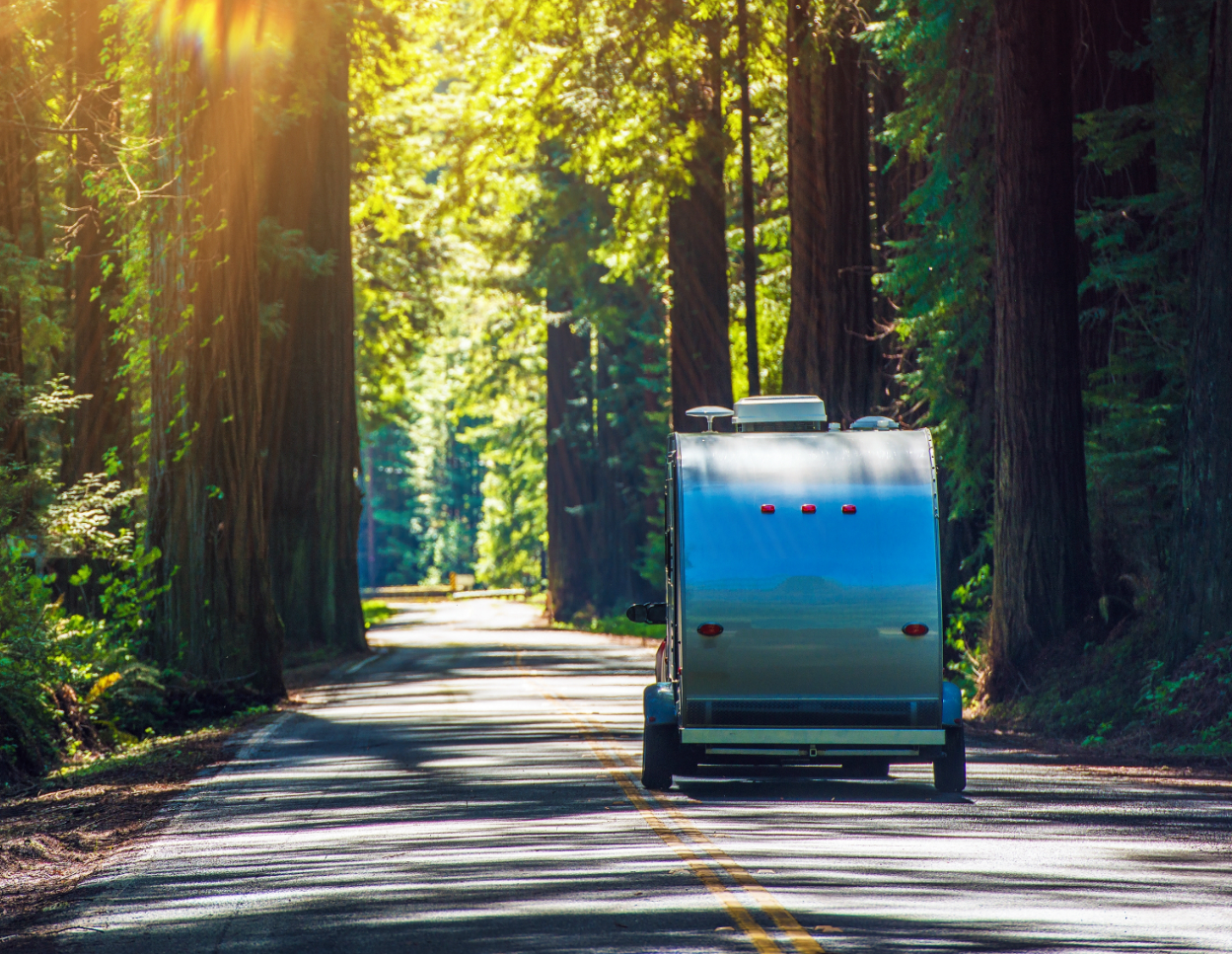 Looking to upgrade your camper’s stereo system? Aren’t we all? We met a couple at Lockn’ Music Festival – Kris Hall and Nick Mullins – who mostly gutted the stereo in their travel trailer and installed a serious system. Their story is below. Warning: Audiophiles will dig the depth of detail Nick queued up. Others’ eyes may glaze over. Pro Tip: Even if you don’t have a camper or care about AV, find people like Kris and Nick who do. They’ll have the best sound around.
Looking to upgrade your camper’s stereo system? Aren’t we all? We met a couple at Lockn’ Music Festival – Kris Hall and Nick Mullins – who mostly gutted the stereo in their travel trailer and installed a serious system. Their story is below. Warning: Audiophiles will dig the depth of detail Nick queued up. Others’ eyes may glaze over. Pro Tip: Even if you don’t have a camper or care about AV, find people like Kris and Nick who do. They’ll have the best sound around.
When we met up with Kris Hall and Nick Mullins at Lockn’ Festival 2019, they were settled into an encampment with their 2017 Forest River 274 VFK. It’s a sweet rig. Spacious and open, the floor plan features a cool v-nose kitchen up front, a separate bedroom in back, and in between, a living room whose slide-out offers a dinette and a jack-knife sofa for friends to bed-down. It has all the creature comforts a music fest or camping host – and their guests – would want.
What really sets their rig apart is the stereo. No factory issue nonsense here. Their upgraded sound system created a campsite with stellar sound. Little surprise it was at the center of their crew’s orbit.
 Kris and Nick learned from experience – and personal preference – that sound elevates the camping mojo. Their previous camper was a Forest River Shamrock 21SS with a tape deck/CD player and two tiny speakers. “We never used the stereo since it was so bad,” Nick said. Instead, they sat a Bluetooth speaker on the table if they wanted to listen to music.
Kris and Nick learned from experience – and personal preference – that sound elevates the camping mojo. Their previous camper was a Forest River Shamrock 21SS with a tape deck/CD player and two tiny speakers. “We never used the stereo since it was so bad,” Nick said. Instead, they sat a Bluetooth speaker on the table if they wanted to listen to music.
Even at RoadtripMojo, the Harmon Kardon Onyx or JBL Flip are constant companions (maybe it’s time for an audio upgrade of our own?).
Therein lies the rub. As we’ve written here before, people drop $20,000, $50,000, even $100,000 or more on a camper or RV – and get a piddly, underpowered stereo system with $2 cones that sounds like it belongs in a Carolla.
Little wonder why they’re so lousy. RV OEMs [insider speak for “manufacturers”] tend to use lower quality inexpensive components in their builds.
“Those who care about sound will want to upgrade them to have a more pleasant audio experience,” hinted an under-stated Ora Freeman, national sales manager with JL Audio, Inc. The company started 40 years ago making custom DJ and car audio cabinets from a South Florida storefront and today is the leader in car, marine, and powersports audio systems.
Music is a big deal to Kris and Nick. They trek to music festivals from February to late October. They’re lifetime members at the Spirit of the Suwannee Music Park in Live Oak, Florida – home to Hulaween, Roots Revival, Spring Reunion, Brainquility, and the new Suwannee Rising fests. And check out their radical-fun loving endeavor, VelvetHippie.
“We have usually have music playing anytime we are in the camper and not sleeping,” said Nick, who’s worked in the 12 volt car, marine, and powersports industry for over 15 years. (check him out at CarTunesAtlanta.com). “We also play music outside of the camper when we are hanging out around the camp fire or relaxing with friends.”
So when he stumbled upon them at Lockn’ (actually, delivering an IKEA bag we’d promised to Kris), we begged details about their audio upgrade.
Truth be told, they’re weren’t going to upgrade the sound. After all, they had a decent portable stereo and the golf cart they trailer to SOSMP has a good sound system. “We figured that if we did use the stereo, it wouldn’t be ‘that bad,’” Nick admitted.
Wrong. When they used the new camper and stereo for the first time at Wanee, they knew an upgrade was in order. The standard-issue Furrion CD/DVD player with Bluetooth had limited range. They could be just outside – literally a few yards and the camper’s wall between their smartphone and the receiver – and the Bluetooth would have trouble staying connected or would “skip.”
What’s worse, the unit’s low power meant the sound would distort when the volume went past about 3/4. That’s not the head unit’s fault; in fact, widely used across the industry, the Furrion is suitable for most RVers. The real culprit there was the speakers themselves. They were small 5-inch midrange drivers with no tweeters. They lacked high range detail and had no bass response at all. That’s audiophile-speak for the speakers sucked.
Go Big or Turn It Down
A change was in order. We’ll let Nick spill the deets (Fair Warning: Audio heads, here’s where you should turn on your laser focus. Others, stay tuned and learn something): “We actually kept the stock unit, added an amplifier and added a bluetooth module. The upgrade started with a JL Audio ‘marine’ Bluetooth receiver called the MBT-RX. It simply plugs into the factory aux input on the back of the Furrion and needs to be connected to a 12-volt power wire that is behind the radio.
“The MBT-RX has Bluetooth 4.0 and the apt-X codec which gives full range frequency response to the headunit. The MBT-RX gives the Bluetooth increased range. We can play music from our phones anywhere inside the camper and outside from at least 15-20 feet. The volume on the Furrion still works as a ‘master volume’ but we can adjust it or our phones. I sometime use my Apple watch from outside to change the volume or tracks if the phone is inside charging.”
As for power – because everyone likes music with moxie: The Furrion stereo was rated at 40 watts “max power” per channel and has 4 channels of output. Two channels run a pair of speakers. “Unfortunately in the car/marine/RV electronics world, words like ‘max power’ are for marketing.” Nick couldn’t find the actual RMS (continuous power) for the Furrion, but based on his experience, its usually 1/3rd or less of the “max power.”
“This would mean it puts out between 10-12 watts RMS,” he said.
His solution: a 4-channel Alpine Power Pack KTP-445U amplifier that puts out 45 watts RMS per channel. The size of a small brick, the compact unit was mounted neatly behind the radio. Very efficient, the amp doesn’t pull a lot of electrical current. The power wires behind the radio were not very large. Most amplifiers require a power wire that has to run directly to the battery of the camper or RV. This is extremely difficult in most campers or RVs because of the way the interiors are assembled and what it takes to get to the battery. The low current draw of the power pack allowed us to use the power wires behind the radio with out having to run anything to the battery.
“The final part of the audio upgrade was to replace the speakers themselves. The interior pair on the ceiling were fairly straight forward to replace. We did have to consider the mounting depth since the ceiling has a little insulation that separates it from the roof of the camper. We chose to use a pair of JL Audio 6.5″ C2-650x speakers. These speakers met the mounting depth restrictions and required almost no modification to mount them where the smaller. We also chose them for their outstanding sound. They have silk dome tweeters that give a smooth, detailed frequency response. The midbass response from the speakers is also very impressive. While it doesn’t sound like a subwoofer, it’s enough to feel way more of the low end that was missing.
“The outside speakers were more of a challenge to replace. The factory outside speakers were the same small speakers as the inside. The difference is that they were cut directly into the metal outside wall of the camper and had very little depth behind them. We had to slightly modify the speaker opening to accommodate a larger speaker. The installer carefully cut out some metal to give us the diameter that we needed. He made a spacer ring out of ABS plastic to give us the depth we needed. JL Audio MX-650-CCX marine speakers were an easy choice to make. These speakers have been designed and tuned specifically for open air environments. They have great sound if you are sitting right in front of them or off to the sides of your campsite. The camper’s outdoor speakers are exposed to the elements 24/7 and we wanted something that was an actual “marine” speaker. The MX JL speakers are made in the USA and were specifically made for harsh environments.
“We do not replace any of the factory speaker wires. They were surprisingly a decent size gauge of wire and since we weren’t running an extremely high wattage amp (150-200 watts PER channel) it was sufficient for this built.
“JL Audio was the only thing I would consider for the marine speakers. I didn’t want to have to replace them every year or two and wanted something that would not only last, but would sound amazing. The amount of engineering they put into their marine speakers is unmatched in the industry.”
Total cost? Over a grand retail, including five hours of a tech’s time. If you know AV and are up to the task, make it your DIY project.
Brass tacks about that sound? In a word, Great.
“Everyone is always surprised at how good it sounds for the small number of speakers it has. One of the things that we weren’t expecting was the amount of bass the outdoor marine speakers would produce. The exterior wall of the camper acts like a giant speaker enclosure and gave more low end then I thought the speakers were capable of. The system won’t rattle the windows of our camping neighbors but it’s more than enough to crank up, not distort, and be the soundtrack of a party.”
A few words to the wise? The installer was wary to eyeball best he could the camper’s hidden wires, vents, water lines, and all kinds of things that may run places you wouldn’t expect.
And beware that volume knob: You may love your tunes, your camping neighbors – especially if you’re camping, but not at a music festival – may not be so smitten.
Click here to read more Pro Tips from the team at JL Audio. If you want Nick’s team to explore amping up your RV, give him a call at 404-444-0783).
